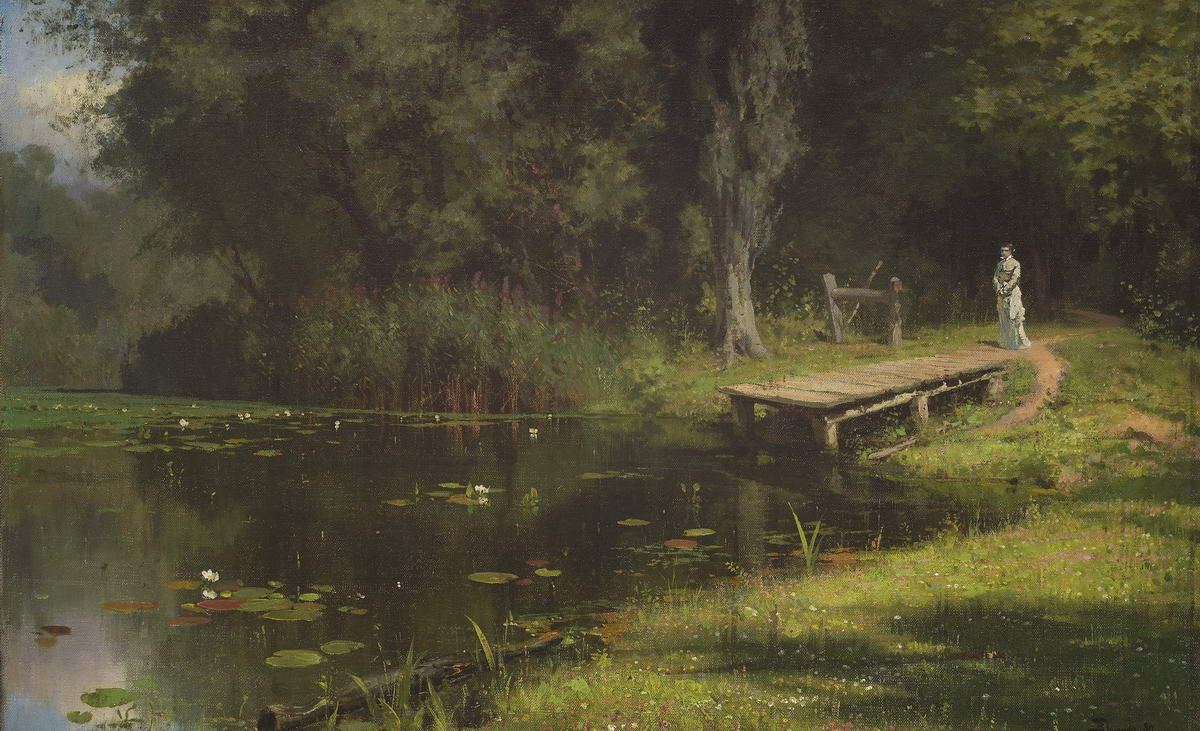


В картине «Заросший пруд» художник поэтически трактует уголок старого усадебного парка, одинокая фигура женщины в его глубине (изображена сестра художника Вера Дмитриевна Хрущева; 1844–1881) усиливает романтическое настроение. Это произведение — один из лучших пейзажей в творчестве Поленова на рубеже 1870–1880-х годов. Русский музей. От иконы до современности. СПб. 2015. С. 213.
Картина представляет собой уменьшенное повторение-вариант одноименной работы 1879 года, находящейся в Государственной Третьяковской галерее.
Живописец. Автор картин на исторические и бытовые темы, пейзажей. Занимался иллюстрацией.
Академик Императорской Академии художеств (с 1876). Народный художник РСФСР (1924). Родился в Петербурге. Брал уроки у П. П. Чистякова и Ф. И. Иордана (1859-1861), в Академии художеств учился у П. В. Басина, Ф. А. Бруни, Т. А. Неффа (1863-1871). Пенсионер Академии в Германии, Франции и Италии (1872-1876), участвовал добровольцем в сербско-черногорско-турецкой войне (1876) и как художник-корреспондент в русско-турецкой войне (1877-1878).
Действительный член Академии художеств (с 1893). Вышел из состава Императорской Академии художеств в знак протеста против расстрела демонстрантов 9 января 1905. Член Товарищества передвижных художественных выставок (с 1878). Совершил путешествия по Ближнему Востоку, Греции (1881-1882, 1899, 1909), побывал в Италии (1883-1884, 1894-1895). Преподавал в Московском училище живописи, ваяния и зодчества (1882-1895). С 1917 жил в усадьбе "Борок" (ныне Поленово, Тульской обл., где с 1939 открыт музей-усадьба).

This painting was typical of the Russian landscapes of the 1870s, in which the genre took second stage to the landscape. The artist offers a poetic interpretation of the small corner of an old estate. The solitary female figure in the depths of the park — the artist’s sister, Vera Khruschova (1844–1881) — intensifies the mood of romanticism. This is one of the finest landscapes in Polenov’s art of the turn of the 1870s and 1880s. Russian Museum: From Icons to the Modern Times. Palace Editions, St Petersburg, 2015. P. 213.
Vasily Polenov often addressed the motif of an old estate park, expressing his romantic disposition and generalising his own impressions of life. The young woman sitting on the bench in this particular work – the artist’s sister, Vera Khruscheva (1844–1881) — is immersed in reflections. Her figure lends an elegiac mood and emotional depth to the landscape. In comparison with Polenov’s landscapes of the early 1870s, Overgrown Pond has a well-organised space, in which the sunlit path leading from the depths of the park plays an important role. The contrasts between the light and shaded sections of the park lend an enigmatic air to the landscape.
Painter, draughtsman, landscape painter, author of works on biblical subjects. Took lessons from Pavel Chistyakov (1859-61) and studied at the Imperial Academy of Arts (1863-67). Graduated from the legal faculty of the St Petersburg University (1871). Fellow of the Imperial Academy of Arts in Germany, Italy, France and Britain (1872-76). Academician (1876), professor of the Imperial Academy of Arts (1892). Member of the Abramtsevo circle (from 1873). Helped to found Sawa Mamontov''''s Russian Private Opera in Moscow (1884). Contributed to many exhibitions. Taught at the Moscow School of Painting, Sculpture and Architecture (1882-94). People''''s Artist of Russia (1926). Opened a museum at the Borok estate (now the Vasily Polenov Estate Museum).



